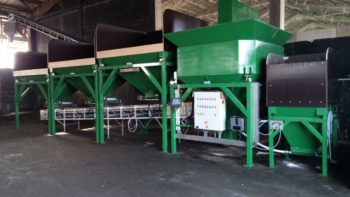Combi blending machines consist of a number of dosing containers, small quantity metering units and pumps which dose the material either continuously or individually onto a central conveyor. The material is then transported into a terminal batch blender. The dwelling time of the fertilizer within the batch blender can be controlled by regulating the inflow and outflow.
This innovative type of blending plant will change the way fertilizers are blended in the long term. It combines the advantages of batch blending with those of continuous systems. With the greatest possible flexibility in the production of mixtures, this system can cope with all conceivable future requirements.
 Combi blending plants consist of a number of dosing containers, small quantity dosing units and pumps which dose the material through continuous blending onto a collecting conveyor belt. The material flow then passes through the terminal batch mixer. The dwelling time of the fertilizer in the batch mixer can be controlled by regulating the inflow and outflow.
Combi blending plants consist of a number of dosing containers, small quantity dosing units and pumps which dose the material through continuous blending onto a collecting conveyor belt. The material flow then passes through the terminal batch mixer. The dwelling time of the fertilizer in the batch mixer can be controlled by regulating the inflow and outflow.
Combi blending plants have several working modes which allow the user to create a wide variety of mixtures. The input of liquids or micro components benefits in a special way from the combination blending system, as the incorporation of these substances can be controlled by the flexible dwelling time in the batch blender (by entering a buffer size in the blender).
The blended components come simultaneously from the dosing containers and pass through the batch blenders. The blending time is controlled by setting the buffer size. Benefit: at high capacities even problematic substances (e.g. liquid dyes) can be reliably incorporated; irregularities of the dosing due to fluctuating material properties are smoothed out.
In batch mode, the batch blender is filled via the dosing devices and/or the stacker. Benefit: the number of blended components is not limited to the number of dosing containers; in the pre- and post-season, individual customers can be served exclusively via the batch blender or specialities desired during the season.
In addition to bulk loading, big-bag filling is an integral part of the combined blender. In the calibrated batch blender, a big bag is assembled, weighed and transferred to the filling station for big bag filling. Manual intervention is not necessary. The process allows just-in-time filling of the big bag, i.e. filling just before delivery.